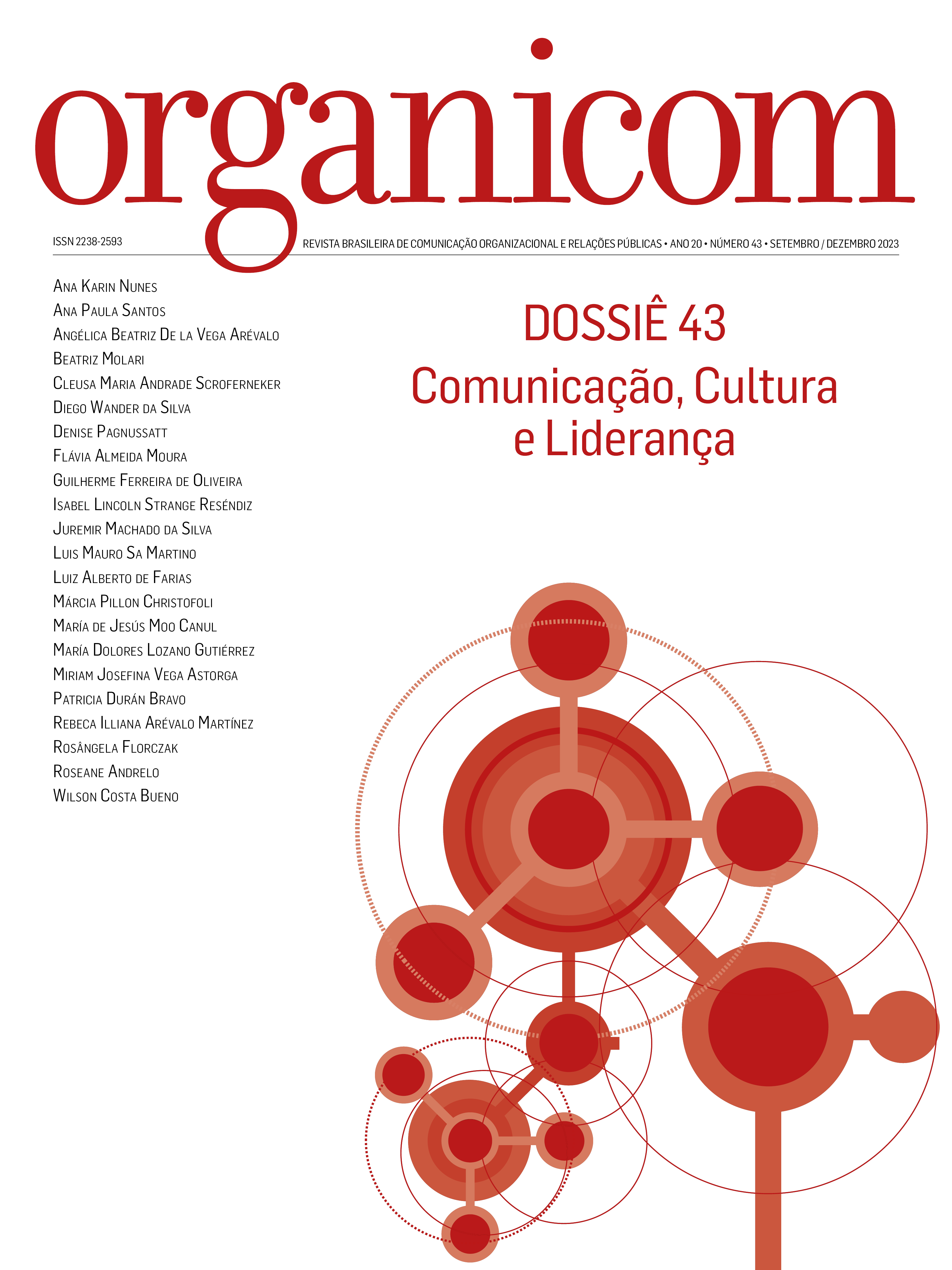Construindo públicos e comunicando a sustentabilidade: lições da Teoria do Público Situacional
DOI:
https://doi.org/10.11606/issn.2238-2593.organicom.2023.212967Palavras-chave:
Comunicação constitutiva, fenômenos comunicativos, sustentabilidade, conservação ambiental, mídia digitalResumo
A comunicação ambiental e turística em áreas protegidas é essencial para promover a sustentabilidade. A teoria situacional dos públicos foi usada para abordar os fenômenos comunicativos no turismo, seguindo um método de revisão teórica multidisciplinar. Descobriu-se que a construção de públicos é influenciada pela metáfora do artista, pelo contexto comunicativo e pela mídia digital. A teoria situacional do público fornece uma estrutura sólida para estratégias eficazes, considerando a mídia digital e abordagens atualizadas.
Downloads
Referências
AGIN, Sol.; KARLSSON, Michael. Mapping the Field of Climate Change Communication 1993–2018: Geographically Biased, Theoretically Narrow, and Methodologically Limited. Environmental Communication, London, v. 15, n. 4, p. 431-446, 2021.
DICAGLIO, Joshua; BARLOW, Kathryn; JOHNSON, Joseph. Rhetorical Recommendations Built on Ecological Experience: A Reassessment of the Challenge of Environmental Communication. Environmental Communication, London, v. 12, n. 4, p. 438-450, 2018.
DOBBINS, Catherine; GIBSON, Kristin; LAMM, Alexa. Promoting Environmental Communication and Policy Formation: A Utilization-Focused Evaluation Approach. Environmental Communication, London, v. 15, n. 7, p. 857-869, 2021.
GRUNIG, James. A situational theory of Environmental Issues, Publics and Activists. In: GRUNIG, Larissa (ed.). Environmental activism revisited: the changing nature of communication through organizational public relations, special interest groups and the mass media. [S. l.]: The North American Association for Environmental Education, pp. 50-82, 1989.
GRUNIG, James; HUNT, Todd. Managing Public Relations. New York: CBS College Publishing, 1984.
GRUNIG, James; GRUNIG, Larissa; APARECIDA-FERRARI, Maria. Perspectivas de las Relaciones Públicas: resultados del Excellence Study para la comunicación en las organizaciones. Revista Mediterránea de Comunicación, Alicante, v. 6, n. 2, p. 9-28, 2015.
GRUNIG, James; KIM, Jeong-Nam. Publics approaches to health and risk message design and processing. In: Oxford research encyclopedia of communication. Oxford: Oxford University Press, 2017.
GRUNIG, James. Strategic Behavioral Paradigm. In: HEAT, Robert; JOHANSEN, Winni. (ed.). The International Encyclopedia of Strategic Communication. New York: Wiley, 2018.
HAN, Byung-Chul. Hiperculturalidad. Barcelona: Herder, 2018.
JONES, M. Embracing a multidisciplinary approach in research. Journal of Interdisciplinary Studies, [s.l .], v. 12, n. 2, p. 45-60, 2018.
KAMIL, Indriyati; ABDOELLAH, Oekan; AGUSTIN, Herlina; BAKTI, Iriana. Dialectic of Environmental Communication in Indonesian Conservation Area. Environmental Communication, London, v. 15, n. 2, p. 203-217, 2020.
KIM, Jeong-Nam; GRUNIG, James. Problem Solving and Communicative Action: A Situational Theory of Problem Solving. Journal of communication, New York, v. 61, p. 120-149, 2011.
KIM, Jeong-Nam; TAM, Lisa; CHON, Myoung-Gi. A conceptual genealogy of the situational theory of problem solving: Reconceptualizing communication for strategic behavioral communication management. In: VALENTINI, Chiara (ed.). Public Relations. Berlin: De Gruyter Mouton, 2021. p. 471-486.
LESSARD, Sarah; MORSE, Wayde; LEPCZYK, Christopher; SEEKAMP, Erin. Using theory to better communicate to different audiences about Whooping Crane conservation. Human Dimensions of Wildlife, London, v. 26, n. 2, p. 148-162, 2020.
LITTLEJOHN, Stephen; FOSS, Karen. Theories of human communication. Long Grove: Waveland Press, 2011.
MAJOR, Ann Marie. Environmental Concern and Situational Communication Theory: Implications for Communicating with Environmental Publics. Journal of Public Relations Research, London, v. 5, n. 4, p. 251–268, 1993.
MÍGUEZ GONZÁLEZ, María Isabel. Teoría situacional de los públicos: las nuevas aportaciones desde la década de los noventa. Comunicación y sociedad, Pamplona, v. 19, n. 2, p. 133-162, 2006.
MILSTEIN, Tema. The Performer Metaphor: “Mother Nature Never Gives Us the Same Show Twice”. Environmental Communication, London, v. 10, n. 2, p. 227-248, 2016.
SMITH, L.; BROWN, C.; DAVIS, R. Advantages of a multidisciplinary approach to understanding complex phenomena. Journal of Multidisciplinary Research, London, v. 7, n. 2, p. 75-89, 2020.
TAO, Weiting; HONG, Cheng; TSAI, Wan-Hsiu Sunny; YOOK, Bora. Publics’ communication on controversial sociopolitical issues: extending the situational theory of problem solving. Journal of Applied Communication Research, [s. l.], v. 49, n. 1, p. 44-65, 2021.
TAZIN, Saidathul Nizah Mat; SHIRA, Haniza Yaakop. Strategic Communication in Public Participation. Journal of Asian Behavioural Studies, Shah Alam, v. 3, n. 10, p. 162-169, 2018.
Downloads
Publicado
Edição
Seção
Licença
Copyright (c) 2023 María de Jesús Moo Canul

Este trabalho está licenciado sob uma licença Creative Commons Attribution-NonCommercial-ShareAlike 4.0 International License.
A submissão implica a cessão de direitos da primeira publicação à revista Organicom, sem pagamento. Os autores podem estabelecer por separado acordos adicionais para a distribuição não exclusiva de versão da obra publicada na revista (como colocar em um repositório institucional ou publicar um livro), com o devido reconhecimento de sua publicação inicial na revista Organicom.


